County Kildare
| County Kildare Irish: Contae Chill Dara Republic of Ireland | |
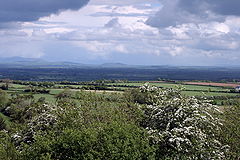 View across the plains of Kildare | |
|---|---|
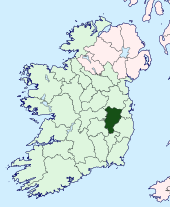
| |
| [Interactive map] | |
| Province: | Leinster |
| Area: | 654 square miles |
| Population: | 210,312 |
| County seat: | Naas |
The County of Kildare is a county in the province of Leinster in the Republic of Ireland. The population of the county is 210,312 according to the 2011 census.
Geography
Kildare is the 24th largest of Ireland’s thirty-two counties in area and seventh largest in terms of population.[1] It is the eighth largest of Leinster’s twelve counties in size, and second largest in terms of population. It is bordered by the counties of Carlow, Laois, Meath, Offaly, Dublin and Wicklow. As an inland county, Kildare is a generally lowland region. The county's highest points are the foothills of the Wicklow Mountains bordering to the east. The highest point in Kildare is Cupidstown Hill on the border with the county of Dublin, with the better known Hill of Allen in central Kildare.
A detached part of the county locally situate in Meath consists of the townlands of Blackditch and Freagh in the parish of Castlerickard and those parts of Derrinlig and Longwood that fall within that parish.[2]
Towns and villages
- Allen
- Allenwood
- Ardclough
- Athy
- Ballitore
- Ballymore Eustace (County Dublin detached)
- Calverstown
- Caragh
- Carbury
- Castledermot
- Clane
- Coill Dubh
- Celbridge
- Derrinturn
- Eadestown
- Johnstown
- Kilberry
- Kilcock
- Kilcullen
- Kildangan
- Kill
- Kilmead
- Kilmeage
- Kilteel
- Kildare
- Leixlip
- Lullymore
- Maynooth
- Milltown
- Moone
- Monasterevin
- Narraghmore
- Nurney
- Naas
- Newbridge
- Prosperous
- Rathangan
- Robertstown
- Sallins
- Straffan
- Staplestown
- Suncroft
- Timolin
Physical geography
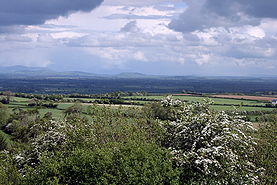
The county has three major rivers running through it: the Barrow, the Liffey and the Boyne. The Grand Canal crosses the county from Lyons on the east to Rathangan and Monasterevin on the west. A southern branch joins the Barrow navigation at Athy. The Royal Canal stretches across the north of the county along the border with Meath. Pollardstown Fen is the largest remaining calcareous fen in Ireland, covering an area of 220 hectares and is recognised as an internationally important fen ecosystem with unique and endangered plant communities, and declared a National Nature Reserve in 1986.
The Bog of Allen is a large bog that extends across 370 square miles of the counties of Kildare, Meath, Offaly, Laois and Westmeath. Kildare has 94 square miles of bog (almost 14% of Kildare's land area) mostly located in the south-west and north-west, a majority of this being Raised Bog. It is habitat to over 185 plant and animal species.
There are 20,935 acres of Forested land in Kildare, accounting for roughly 5% of the county's total land area. 10,023 acres of this is Coniferous, while there is 7,322 acres of Broadleaf and the remaining area are Unclassified Species. Coillte and Dúchas currently own 47% of the forestry. Coillte run Donadea Forest Park which is in North-Central Kildare. The forest covers 259 hectares of mixed woodland (60% Broadleaf, 40% Conifer) and is the largest forest park in Kildare.
History
Kildare was formed as a shire in 1297.[3] The county was the home of the powerful Fitzgerald family. Parts of the county were also part of the Pale area around Dublin.
Demographics
The county's population has nearly doubled to some 186,000 in 1990-2005. The north-eastern region of Kildare had the highest average per-capita income in Ireland outside County Dublin in 2003. East Kildare's population has increased rapidly, for example the amount of housing in the Naas suburb of Sallins has increased sixfold since the mid-1990s. As of 2011 the population of the county is 210,312 with 37% (77,832 people) being under the age of 25.[4]
Economy
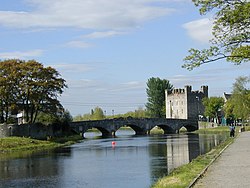
Kildare currently (2010) contains the European base of electronics firms, Intel and Hewlett Packard, two of the largest employers in this sector in the entire island. Pharmaceutical giant Pfizer has its European Manufacturing base in Newbridge, with another plant in nearby Newcastle in County Dublin. Major pizza-making, soft drinks, and frozen food enterprises are located in Naas. Large supermarket distribution centres are located in Naas, Newbridge and Kilcock. The Irish Army's largest military base containing its command headquarters and training centre is located at the Curragh.
Kildare is the centre of the Irish horse industry. Kildare has more stud farms than any other county in Ireland. Several prominent international breeders have substantial stud farms in Kildare, including many from the Arab world.
- Racecourses (at Punchestown, Naas and the Curragh)
- The Irish National Stud farm (Kildare town)
- The National Equestrian Centre (Kill)
- Equine auction centre (at Goffs in Kill).
County Kildare is the richest county in Ireland outside of Dublin and has the lowest unemployment rates in Ireland, throughout the economic recession of the 1980s. House prices in the county but especially in the north-east of the county e.g. Naas and Maynooth have always been considerably higher than the other counties in the country outside Dublin. Kildare was the first county in Ireland to experience the Celtic Tiger economic boom in the early 1990s, mainly as a result of the decision of Intel to locate between Leixlip and Maynooth. From various high tech companies like Intel and Hewlett Packard the county is sometimes dubbed "the Silicon Valley of Europe", and had a pick up in construction that predated that of other counties.
The most economically developed part of the county is around the towns of Naas, Maynooth, Celbridge, Leixlip and Kilcock. Agriculture dominates around the towns of Athy, Kildare, Newbridge, Monasterevin and Rathangan.
Transport
Road
County Kildare houses the hub of Ireland's network of major roads.
The N4 (M4) from Dublin to Sligo travels along the north of the county by-passing the towns of Leixlip, Maynooth and Kilcock.
The N7 (M7) from Dublin to Limerick runs through the county and by-passes the towns of Naas, Newbridge, Kildare and Monasterevin. This road is colloquially referred to as the "Naas Dual carriageway" since its upgrade in 1964.
The N9 (M9) is another National Primary Route that commences at Kilcullen and ends at Waterford.
Rail
The County is also served by the trains connecting with Dublin, South Leinster, Munster and South Connaught, with daily connections to Cork, Waterford, Limerick, and Galway. The principal Irish Rail intercity train station in the county is Kildare, however, Newbridge, Sallins, Maynooth and Hazelhatch are also served by a Dublin commuter train service called the Arrow.
Waterway
Kildare is the centre of Ireland's Grand Canal network built in the late 18th century. This connects Kildare with Waterford, Dublin, Limerick and Athlone. The Royal Canal runs west from Dublin and parts of it form the boundary with County Meath.
Education
- Two third-level educational institutions – St. Patrick's College founded by King George III in 1795 to educate Ireland's Catholics and the National University of Ireland, Maynooth founded in 1997—are located in Maynooth. They share campus space and many facilities. The two institutions were formally separated in 1997. NUI Maynooth is the only university in the Republic of Ireland not situated in a city.
- Clongowes Wood College is a private secondary boarding school for boys, located near Clane. Founded by the Society of Jesus (The Jesuits) in 1814, it is one of Ireland's oldest Catholic schools.
- The town of Clane is home to another educational institute, Clane College, a provider of further education to the wider Kildare community.
- Newbridge College is a co-educational secondary school. The Dominican Order founded Newbridge College in 1852 as a boarding school for boys.
- Pipers Hill College Naas is a second level college opened in August 2009 to replace St Patrick's Community College.
People
- George Barrington: Pickpocket, socialite
- Teresa Brayton: Writer
- Eamon Broy: Policeman
- Domhnall Ua Buachalla: Governor-General of the Irish Free State
- Ambrose Bury: Candanian Politician
- Paul Cullen: Archbishop of Dublin and Archbishop of Armagh
- Nonpareil Dempsey: Boxer
- John Devoy: Fenian
- Charles FitzClarence: Soldier
- Lord Edward FitzGerald: Revolutionary
- Matt Goff: Gaelic footballer
- Arthur Guinness: Brewer
- Willoughby Hamilton: Tennis Player
- Gabriel Hayes: Sculptor & Coin Designer
- Aidan Higgins: Writer
- John Vincent Holland: Soldier
- Molly Keane: Novelist
- Michael Kelly Lawler: Soldier
- Emily Lawless: Writer
- Mary Leadbeater: Writer
- Kathleen Lonsdale: Scientist
- Devon Murray: Actor
- John de Robeck: Admiral
- Ernest Shackleton: Explorer
- Barry St Leger: Soldier
- Damien Molony: Actor
Sport
GAA
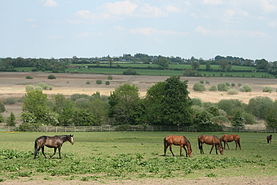
The nickname for the Kildare GAA team is the Lilywhites, a reference to the all-white jerseys they wear.
In 1928, Kildare became the first team to win the Sam Maguire trophy for the All Ireland football Championship, defeating Cavan 2-6 to 2-5.
County Kildare is also known as the Shortgrass County which is a reference to how short the grass is on the commons of the Curragh.
Golf
The K Club, situated on the River Liffey near Straffan played host to the 2006 Ryder Cup. Other prominent courses are located at Knockanally, Carton Estate, and Clane.
Horse racing
Kildare is famous worldwide for its horse racing.[5][6] The Curragh horse-racing course is the home to all five Irish Classic Flat races. Also located in County Kildare are two other courses, Punchestown Racecourse, home of the National Hunt Festival of Ireland, and Naas Racecourse, which runs both National Hunt and Flat meetings and is used by top race horse trainers as a test for horses preparing for the Cheltenham festival.
The county is famous for the quality of horses bred in the many stud farms to which it is home, including the Irish National Stud and many other top studs such as Gilltown, Moyglare and Kildangan Stud, and race horse training establishments, such as the Osborne Stables.
References
- ↑ Corry, Eoghan (2005). The GAA Book of Lists. Hodder Headline Ireland. pp. 186–191.
- ↑ Townlands of Blackditch and Freagh and those parts of Derrinlig and Longwood all within the parish of Castlerickard: 53°27’55"N, 6°55’42"W
- ↑ Otway-Ruthven, Annette Jocelyn (1980). A history of medieval Ireland. Routledge. p. 174. ISBN 0-510-27800-0. http://books.google.com/books?id=K_4NAAAAQAAJ&pg=PA174.
- ↑ "County Kildare". Central Statistics Office. 2011. http://census.cso.ie/sapmap2011/Results.aspx?Geog_Type=CTY&Geog_Code=06&CTY=06.
- ↑ "Passion for Horses, The New York Times". Newswoman.de. 1995-04-16. http://newswoman.de/clips/kildare.html. Retrieved 2011-12-27.
- ↑ http://www.kildarehorse.ie/
Outside links
- Kildare Fáilte's Tourism Pages
- County Kildare Community Network
- Clane College
- Kildare Gaelscoil stats 2010-2011
- Irish Census 2006
| Counties of the Republic of Ireland |
|---|
|
Carlow • Cavan • Clare • Cork • Donegal • Dublin • Galway • Kerry • Kildare • Kilkenny • Laois • Leitrim • Limerick • Longford • Louth • Mayo • Meath • Monaghan • Offaly • Roscommon • Sligo • Tipperary • Waterford • Westmeath • Wexford • Wicklow |